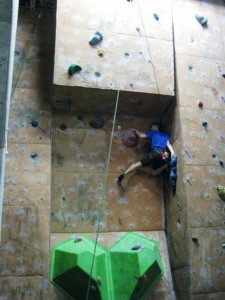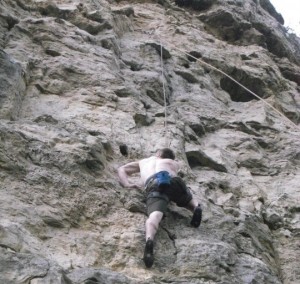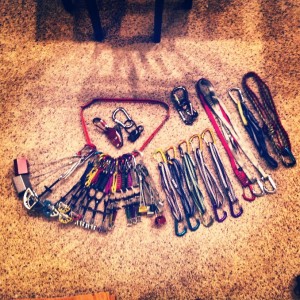This most assuredly will be different for every individual out there, and after a quick Google search, there are no lack of opinions on the matter. So, what the hell, I’ll try to generalize, come up with a couple of different scenarios, and add mine too.
Keep in mind, this is gear only. I’m not addressing the safety knowledge that should be acquired leading up to and at each of these steps. I’m assuming that you are sufficiently learning these skills as you go, and I will speak as if that’s true.
 Try It
Try It
Before you go out and buy anything, please pay for a day pass at an indoor gym and try rock climbing first. Bouldering requires the least amount of gear, but I suggest going with an experienced friend or ask a random climber for a belay and get on some ropes. If you feel like this could be a new, regular hobby of yours, read on. If not, hasta luego!
Top Roping Gear for Beginners
It’s likely that the first type of climbing you’ll encounter, indoors or out, will be top roping. For this scenario, I will assume you’re going with someone more experienced that has all the required anchoring gear and is teaching you the barebones basics. I will also assume that they’ve already taught you how to safely belay. For this you will need your own harness and rock climbing shoes. Your more prepared and more experienced partner *could* help you out by sharing his/her chalk bag with you as well as their belay device. That’s all you need!! (Though, you may want to offer your unofficial guide a beer or two or three.)
Top Roping Gear for the “A Little More Than Beginner” Crowd
 By this time, you’re hooked on climbing, and you don’t want to keep mooching off your more experienced partner. Or maybe it’s costing you more money buying beer than just buying the gear. At this point you should have, or buy, the following:
By this time, you’re hooked on climbing, and you don’t want to keep mooching off your more experienced partner. Or maybe it’s costing you more money buying beer than just buying the gear. At this point you should have, or buy, the following:
- Harness
- Rock climbing shoes
- Chalk bag
- Belay device*
- Locking carabiner(s)
* Belay device – The belay device you choose is dependent on how far you really think you’re going to take your new favorite hobby. If you know for a fact you’re only going to climb indoors or on the odd occasion you get asked to go outside, you can probably get away with a standard ATC (cheapest). However, if you feel like you’re going to get into lead climbing and multi-pitch, I highly suggest you spend the extra money once and get and ATC Guide (not as cheap). It’s cheaper in the long run than buying both. Obviously. Or, if money doesn’t concern you, step up to an auto-locking device (like a Gri-Gri – most expensive). You can’t go wrong with an auto-locker because they are the safest belaying mechanism and can be used with any type of belay system. Personally, I own all three.
The Independent Top Roper
You love climbing!!1!1! Congrats! Me too! You don’t want to depend on other people. You want to contribute. You want to go with people that are less experienced than you. So now you have to be the person with the gear. This also assumes you have access to the top rope anchors and do not need to lead climb in order to get there. In addition to the gear above, you will now also need:
- Rope
- Personal anchoring system
- Anchor building equipment*
- Non-locking carabiners
- (Maybe) More locking carabiners (depending on how many you bought before)

You probably don’t need all of this, and there’s other things not pictured that you should get before. Like webbing or static cord.
* Anchor building equipment – This is highly dependent on the area(s) you climb. Some places will require the full range of trad gear** to build your anchor from the available rock features. Others will require feet upon feet upon feet of webbing and/or static cord to wrap around blocks of rocks, trees, or other permanent features. It could also be as simple as needing to clip a couple sport draws into existing bolts.
** Trad gear – A few examples (all with a large range of sizes): cams, nuts, hexes, tricams, runners
Sport Climbing Gear for Beginners
And this is where this post ends. Anything beyond sport climbing and I think we’ve left the realm of “beginners”. By the time you’re considering trad leading, you’re well on your way. Luckily you’ve already bought the bulk of the gear and you only need one more thing:
- Sport draws (quick draws)
Sport draws are usually sold individually or in packs of 4, 5, or 6. Regardless of how you buy them, I suggest getting at least 12 total for long climbs. Heck, you might already have bought some for your top rope anchoring system.
As I said, by now, you’re ready to lead up to the anchors or lead up to the top of the climb and build your own anchor. You should be competent enough to bring some n00bs, set them up on a top rope system so they can enjoy the sport, and teach them everything you know.
Am I missing anything? (Probably)







